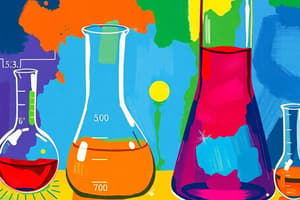Podcast
Questions and Answers
What is the purpose of reacting chloride ions with silver nitrate?
What is the purpose of reacting chloride ions with silver nitrate?
- To precipitate AgCl (correct)
- To form NaCl
- To neutralize the solution
- To create a basic solution
In the titration involving sodium hydroxide, what does the concentration of 0.27 mol dm-3 refer to?
In the titration involving sodium hydroxide, what does the concentration of 0.27 mol dm-3 refer to?
- Concentration of NaOH (correct)
- Concentration of NaCl
- Concentration of HCl
- Concentration of AgNO3
What would happen if you neutralize 100 cm3 of 0.01 mol/dm3 phosphoric acid with an insufficient volume of sodium carbonate?
What would happen if you neutralize 100 cm3 of 0.01 mol/dm3 phosphoric acid with an insufficient volume of sodium carbonate?
- Formation of more CO2
- Incomplete neutralization (correct)
- Formation of Na3PO4
- Release of excess water
Which substance is used to titrate the LiOH(aq) solution in the given scenario?
Which substance is used to titrate the LiOH(aq) solution in the given scenario?
Why is the inability to follow instructions considered an invalid conclusion?
Why is the inability to follow instructions considered an invalid conclusion?
What is the role of silver nitrate in removing chloride ions?
What is the role of silver nitrate in removing chloride ions?
Why is it essential to calculate the concentrations of solutions in mol dm-3?
Why is it essential to calculate the concentrations of solutions in mol dm-3?
What does the presence of AgCl indicate in a chemical reaction involving silver nitrate?
What does the presence of AgCl indicate in a chemical reaction involving silver nitrate?
How does the mass of solid required relate to the concentration of a solution?
How does the mass of solid required relate to the concentration of a solution?
Inaccurate techniques can lead to what kind of experimental results?
Inaccurate techniques can lead to what kind of experimental results?
Flashcards are hidden until you start studying
Study Notes
Measurement Units
- Solids are measured in mass (g, kg, tonnes)
- Liquids and gases are measured in volume (mL, cm3, dm3, L)
Moles
- A mole is a counting unit for a number of particles (atoms/molecules)
- 1 mole = 6.022 x 10^23 atoms (Avogadro's number)
- Number of particles (N) = number of moles (n) x Avogadro's number (NA)
Molar Mass
- Molar mass is the mass of one mole of a substance
- Molar mass = volume (V) x molar volume (Vm) x number of moles (n)
Molar Volume
- Molar volume is the volume of one mole of a gas
- Molar volume depends on the temperature and pressure of the gas
- At room temperature (20°C) and room pressure (1 atm), molar volume = 24.0 dm3
- At standard temperature (0°C) and standard pressure (1 atm), molar volume = 22.4 dm3
Gas Laws
- Gay-Lussac/Avogadro's Law: The ratio of volumes of gases is equal to the ratio of their stoichiometry
- Boyle's Law: If the pressure of a gas is doubled, the volume halves
- Charles' Law: If the temperature of a gas is increased, the volume increases
Titration
- Titration is a method of determining the concentration of a solution
- A known volume of a solution of known concentration is reacted with a solution of unknown concentration
- The volume of the known solution required to react with the unknown solution is used to calculate the concentration of the unknown solution
Titration Calculations
- Moles of reactant = volume of reactant x concentration of reactant
- Moles of product = moles of reactant x stoichiometric ratio
- Molar mass of product = mass of product / moles of product
Errors and Accuracy
- Accuracy is a measure of how close a result is to the true value
- Precision is a measure of how close a set of results are to each other
- Percentage error is a measure of the accuracy of a result
Sources of Error
- Instrument error: error due to the limitations of the measuring instrument
- Environmental factors: error due to changes in the environment during the experiment
- Human error: error due to human mistakes or biases
Instrument Error
- Each instrument has an inherent error due to its limitations
- The error depends on the precision of the instrument and how well it has been made
Precision in a Titre
- To calculate a titre, two readings are taken from the burette
- The precision of the titre depends on the precision of the burette readings
Studying That Suits You
Use AI to generate personalized quizzes and flashcards to suit your learning preferences.




